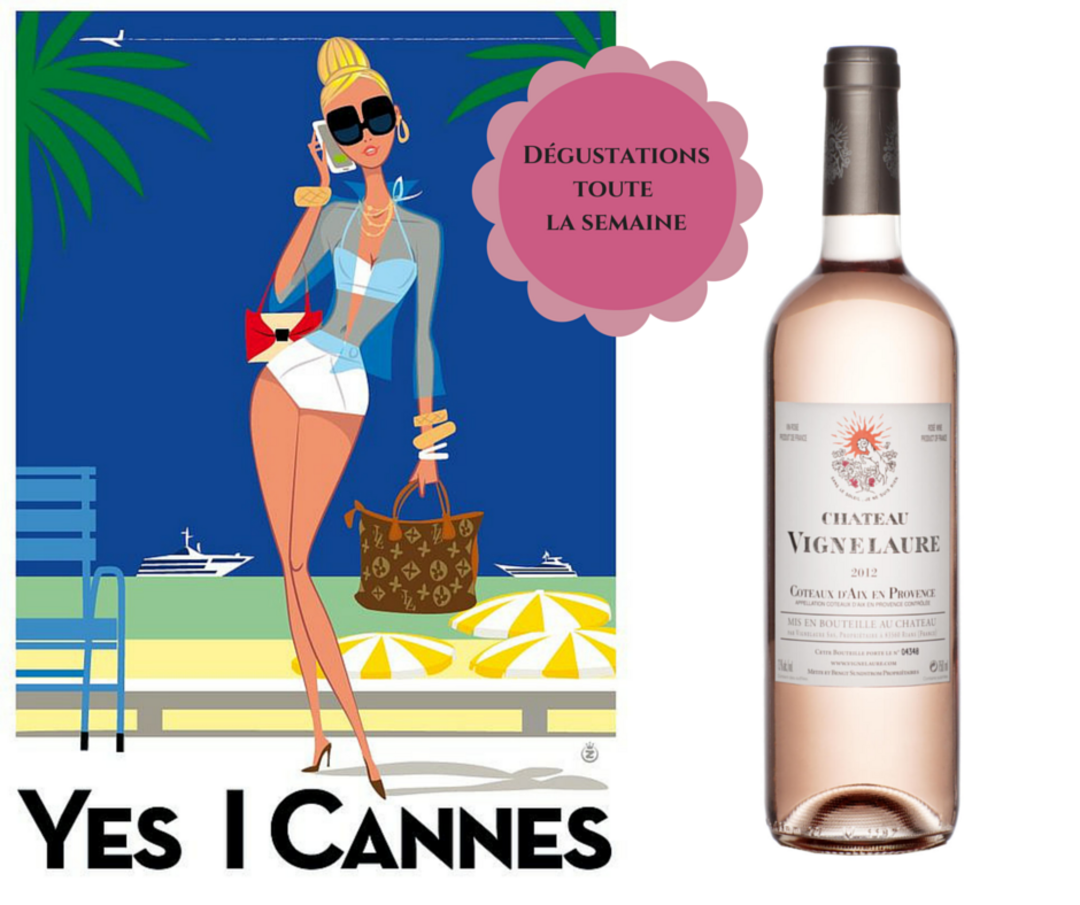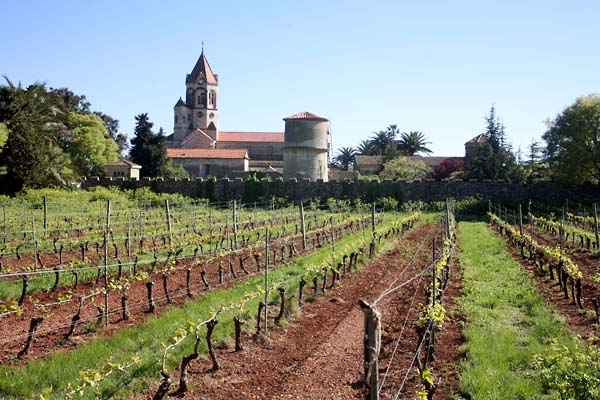Wine, Films, Action!
The world of film has had a long connection with Provence, so while the cinema industry focuses on Cannes for the next two weeks for the 69th Cannes Festival of Film (11-22 May 2016), I thought I would do a fun round up of a few film and wine connections in Provence.
*** STOP PRESS **** Jean-Baptiste Pacioselli (whose parents run Domaine St Jean in Bellet) and Kyrian Rouvet of WellKy Films won three awards: 'Best Original Screenplay of a Foreign Language Film','Best Crime Film' and the 'Audience Choice Award' in the short films category on Friday 13th May 2016 for 'The Last One.' Congratulations!


Domaine Ott* rosé
With the port of Cannes minutes from the Palais de Festivals, yachts are hired during the film festival for accommodation, outings, parties - some superyachts are large enough to host 100 or more people.
Louise Sydbeck MW of Riviera Wine, the wine branch of Riviera Yacht Support, a supplier to the yachting industry, noted that working with top names such as 'Petrus, Cheval Blanc, Cristal (champagne) and anything with the name Montrachet on the label' is part of the normal sales year round, but 'for the film festival, it's different, most of it is big brand Champagne for the parties: Veuve Cliquot, Ruinart and Moët are popular.' Not everything has to be expensive; she continued 'A few years ago, we had a request from a yacht for some inexpensive sparkling wine so we suggested a good Prosecco for around 8€. To our surprise this was also too pricey! In the end we managed to find some sort of carbonated wine for 3€ a bottle! In other words, it’s not all glory in yachting, especially not during the festival!'
Another local wine supplier reports that rosé, especially Domaines Ott*, champagne, and especially rosé champagne are the most popular wines. With some stars only ordering Dom Perignon rosé or Champagne Laurent Perrier rosé.
Brad Pitt and Angelina Jolie famously escaped the Festival crush by renting Domaine Miraval, some two hour’s drive away. They ended up buying the estate and making their award-winning rosé wine, which, interestingly is packaged in a bottle almost identical to that of Champagne Ruinart.

25th anniversary bottles
For the 25th year, the Bordeaux estate Baron Philippe de Rothschild SA will be hosting the rooftop 'Mouton Cadet Wine Bar' at the Palais des Festivals. This year the bar has been designed by Parisian designer, Mathias Kiss, who worked on the theme of the ‘sophisticated mix between timeless French Riviera aura and Hollywood glamour brought by 1950’s American stars … incorporating Palm Springs modern architecture with French Art Deco inspiration.’
Rothschild's Mouton Cadet wines: 2015 white and rosé and a 2014 red, decorated with the festival logo and reels of film, will be served at the Festival's official events and dinners.
In 1955, Oscar-winning actress Grace Kelly came to the Cannes Film Festival. She was invited to Monaco to meet Prince Rainier of Monaco and a whirlwind romance started. A year later, in 1956, they married and the small principality became part of the Hollywood dream. 1955 was also a significant year for Provence wine, when the 22 top estates were granted Cru Classé status (the region at that time had not yet been granted its appellation controllée).
Another sponsor, for the critics week, when new young film makers are looked at, during the Cannes Film Festival, is the Vins Méditerranée IGP. Each year a wine is selected in a blind tasting, and this year the wine being offered is the rosé of Château Vignelaure from the region of Coteaux d'Aix.

Vins Méditerranée IGP and Chateau Vignelaure
Nice, situated between Cannes and Monaco, was home to the once teeming Studios Victorine (behind the city’s western station St Augustin.) It was founded in 1919, and many French films were made there. Its heyday can be appreciated in the film Day for Night by François Truffaut, which shows the studios in full activity. It was screened at the 1973 Cannes Film Festival and won the Oscar for Best Foreign Language Film in 1973. The vineyards of Bellet lie on the hills beyond those in the picture below.

On the set at Studios Victorine
Just off-shore from Cannes, lies the group of îles de Lérins. The fort on the island of Ste Marguerite is home to the prison where The Man with the Iron Mask (1998 movie with Leonardo di Caprio) was imprisoned. The neighbouring island of St Honorat is occupied by a monastery, the Abbaye Notre Dame de Lérins, established in the 5th century, with its own restaurant, La Tonnelle, and vineyards where a range of wines is made by the monks at the monastery. Other wines, local to Cannes, were reviewed a few years ago.

île St Honorat vineyard
Further west along the coast is St Tropez, made famous when the young Brigitte Bardot starred in Roger Vadim’s film And God Created Woman (1956) – with interior scenes shot at Studios Victorine in Nice . This helped to catapult the picturesque fishing village to stardom, and flocks of ever-hopeful 'starlets' started to parade the streets with the hope of being spotted. Today, St Tropez remains a town in which to 'people-watch.'
Many films have been set in and around St Tropez – though this is not always obvious. The beach scene in Chitty Chitty Bang Bang (1968) where they sing ‘Truly Scrumptious’ was, much to my amazement, filmed on the beach at Cap Taillat just outside the town.

Chitty-Chitty-Bang-Bang
Le gendarme de Saint-Tropez (1964), starring Louis de Funès, is based in the town, with a plot involving the local police, nudist beaches and art thefts.
Villas, medieval hill top villages such as Gassin, Ramatuelle and Grimaud, and vineyards jostle for position throughout the peninsula. There are many vineyards in the region including the three co-operatives Les Maîtres Vignerons de St Tropez, Les Fermes de Lice and the Vignobles de Saint-Tropez (with brand name Chevalier Torpez), all using grapes from small plots scattered throughout the region. Torpez has a range of rosé wines from different parcels which show the different terroirs of the peninsula. The most well-known domaines are Chateau Minuty and Domaine de la Croix & de la Bastide Blanche.
Cassis, a beautiful fishing town, is where the Lumière Brothers made some of the first films in the 1890s. They showed films at the Eden Cinema in nearby La Ciotat, opened in 1895, the world’s oldest cinema. Films can still be watched at the cinema.

The Eden Cinema
Before phylloxera in the 1880s, the vineyards of Cassis were known for their sweet white wines and vin cuit. When replanting their vineyards, they used the same white varieties, but as the market was now more interested in dry white wines, the Cassidiens started to make dry wines. In 1936, Cassis was one of the first six wine appellations created, so the twelve Cassis vineyards are celebrating their 80th anniversary throughout 2016.

Vineyards of Cassis with Chateau d'If in the distance
The city of Marseille, the second largest in France and the country's largest port, has been the setting for many films, including a brief scene in Laurel and Hardy’s final film Utopia (1951), French Connection II (1975) and scenes in the political thriller The Statement (2003). Just off-shore is the famous Chateau d’If where the Count of Monte Cristo was imprisoned (latest film 2002).

Chateau d'If
In Marseille a small micro-cellar, the Micro Cosmos Chai Urbain, run by Fabienne and Lukas Völlmy, makes single cuvées from selected parcels and from single varieties, around Marseille.
The stories of Marcel Pagnol, set in the once-rural villages around Marseille, have been turned into many films. Jean de Florette and its sequel Manon des Sources (1986) tell the story of the importance of water for the local farmers. The value of these natural springs has a clear link to modern vineyards. Estates, with history going back to Roman times, invariably have their own water source.
In 1989 Peter Mayle wrote A Year in Provence, a humorous account of his restoring his house in the Luberon. This sparked enormous interest in the region of Provence. I remember hosting a Provence wine tasting in an art gallery exhibiting the book's illustrations by Judith Clancy. The film based on Mayle’s book A Good Year (2006) is set in the village Lourmarin, where British entrepreneur William Chase, with skilled Australian winemaker Dale Clarke, is producing some superb wines at Chateau Constantin.

Scene from 'A Good Year'